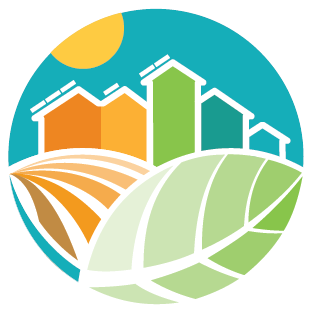Making sense of the Housing & Climate Crises in Davis
What is the status of affordable housing in Davis?
Davis is an ideal place to live as the home to UC Davis with great access to parks and greenbelts, a vibrant downtown, and proximity to Sacramento and the Bay Area. Davis has a majority of single family homes with apartment complexes resulting in a mix of low to medium density across the city (see graphic for percentages).
The demand for housing in Davis results in a vacancy rate (i.e., the share of units that are available for occupancy) of only 1.5 percent, which is highly constrained compared to typical 5-6% vacancy rates (1). This leads to extremely high housing costs for renters, causing many Davisites to struggle making ends meet and for many people to find a life in Davis out of reach (2). This also causes many people who work in Davis to commute, adding to greenhouse gas emissions.
These two figures from our 2021-2029 Davis Housing Element show the rates of owners paying more than 30% of their incomes (the rate that is considered overburdened) on housing is unacceptably high. For renters, the situation is even more dire (3).
How much new housing do we need to address this?
Each city and county is required by the State to produce a Housing Element as part of their General Plan that demonstrates their ability to meet the housing need identified in the Regional Housing Needs Allocation or RHNA. For the 2021-2029 Housing Element, the City of Davis must plan for at least 2,075 housing units to address the housing shortage and 60% of those units must be affordable (4). Thus far, our plan to meet this need has not been accepted by the state, in part of questions around whether affordable housing will actually be built on the parcels we identify as potential development sites (5). The need is clear—we must build more affordable housing to address this crisis now and for the future.
But what and whose future are we building for?
Climate change is causing temperatures which are the hottest on record in the human era. 2023 is on track to be the first year where global temperatures will exceed the 1.5 degree Celsius increase over pre-industrial times that global leaders agreed we would not cross in the so-called ‘Paris agreement’ of 2015. These higher temperatures bring more extreme weather with heat, flood, drought, and storms in Davis and around the world. By 2035 Davis is projected to have a 4-5 degree Fahrenheit baseline temperature rise (6) and 23-58 days over 104 degrees per year (7). To compare, the Summer of ‘23 had 12 days over 104. To build and retrofit housing for people to survive in this new climate reality, we must innovate the designs for homes and neighborhoods to match.
There is hope for both the housing crisis and the climate crisis. It starts with community action to achieve 3 goals:
1) Rapidly mitigate future emissions of greenhouse gases and 2) adapt to the change in our climate already in motion in order to 3) build resilient, inclusive, green communities focused on people.
Resilience means working together to overcome challenges, find solutions, and persevere. There are new methods for housing and urban design that can lower greenhouse gas emissions while also ensuring the health and safety of residents, including our most vulnerable neighbors. These methods are specified in Davis’ newly adopted Climate Action and Adaptation Plan (8) with goals for meeting the climate and housing crisis simultaneously. These include green building design, full electrification, and higher density developments that include affordable housing and equitable neighborhoods. Livable communities that are walkable and well-connected by bike and public transport. Landscapes and streets designed to keep us cooler and prepared for occasional intense rainfall and flood. Locally generated renewable energy production and storage towards a more stable local electricity grid. While the climate plan charts a way forward, current city plans on housing do not. Despite having many good strategies for the future of city, our General Plan (9) and its Housing Element are both out of date and require significant changes to meet our challenges.
DCAN wants the Davis community voice, especially those over-burdened and under-represented, centered in the development of a new General Plan in order to secure a better and more equitable future for everyone in our community.
What can you do? The mission of DCAN is to advocate for a climate justice approach to housing and neighborhood design, with a focus on expanding affordable housing for an inclusive and sustainable our community. And we need you to join the movement!
Join public engagement opportunities to advocate the future you want to see in the new developments coming up for votes in Davis
Sign up for action alerts from DCAN for critical votes, events, and community connection
Donate to housing and climate causes and non-profits locally
The Davis community can say YES to innovative designs for climate justice and affordable housing in our neighborhoods. Together, Davis CAN!
(1) https://www.cityofdavis.org/city-hall/community-development-and-sustainability/planning-and-zoning/2021-2029-housing-element-version-2, clean version, pg 69.
(2) This graphic was modified based on an original design by Opticos Design Inc. Original included in What is Missing Middle Housing? Published by the City of Sacramento, 2023.
(3) https://www.cityofdavis.org/city-hall/community-development-and-sustainability/planning-and-zoning/2021-2029-housing-element-version-2, pgs 145-146.
(5) https://documents.cityofdavis.org/Media/CommunityDevelopment/Documents/PDF/CDD/Advance-Planning/Housing%20Element%20Update%202021%20-%202029/Davis-NOV083123.pdf
(6) https://lao.ca.gov/reports/2022/4584/Climate-Change-Impacts-Housing-040522.pdf, pg 3
(7) https://cal-adapt.org/tools/extreme-heat/. Based on location using zip code 95616.
(8)https://www.cityofdavis.org/sustainability/2020-climate-action-and-adaptation-plan-caap#:~:text=The%20City%20of%20Davis%202020,and%20carbon%20reduction%20policies%20toward
(9) https://www.cityofdavis.org/city-hall/community-development-and-sustainability/planning-and-zoning/general-plan




